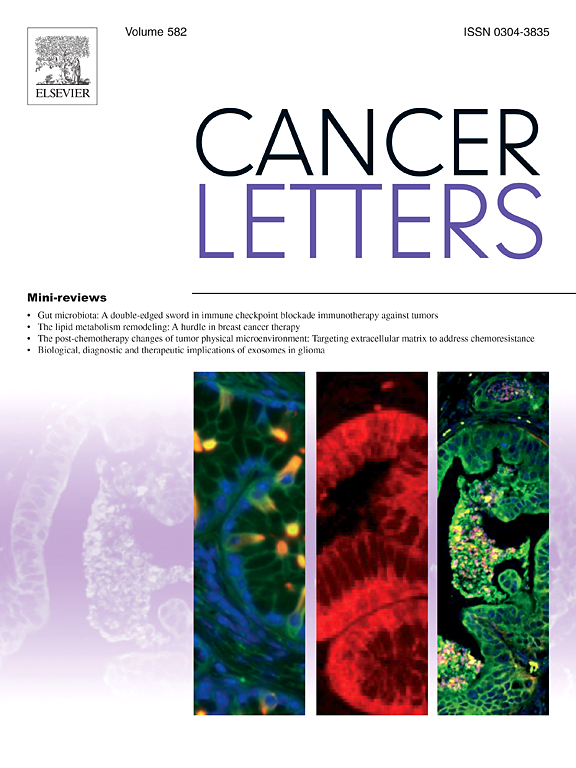Revisiting the CXCL13/CXCR5 axis in the tumor microenvironment in the era of single-cell omics: Implications for immunotherapy
IF 9.1
1区 医学
Q1 ONCOLOGY
引用次数: 0
Abstract
As one of the important members of the family of chemokines and their receptors, the CXCL13/CXCR5 axis is involved in follicle formation in normal lymphoid tissues and the establishment of somatic cavity immunity under physiological conditions, as well as being associated with a wide range of infectious, autoimmune, and tumoral diseases. Here in this review, we focus on its role in tumors. Traditional studies have found the axis to be both pro- and anti-tumorigenic, involving a variety of immune cells, including the tumor cells themselves and those in the tumor microenvironment (TME), and the prognostic significance of this axis is clinical context-dependent. With the development of techniques at the single-cell level, we were able to explain in detail the status of the CXCL13/CXCR5 axis in the TME based on real clinical samples and found that it involves a range of crucial intrinsic anti-tumor immune processes in the TME and is therefore important in tumor immunotherapy. We summarize the cellular subsets, physiological functions, and prognostic significance associated with this axis in the most promising immune checkpoint inhibitor (ICI) therapies of the day and summarize possible therapeutic ideas based on this axis. As with any TME study, the most important takeaway is that the complexity of the CXCL13/CXCR5 axis in TME suggests the importance of personalized therapy in tumor therapy.
在单细胞全息技术时代重新审视肿瘤微环境中的 CXCL13/CXCR5 轴:对免疫疗法的启示
作为趋化因子及其受体家族的重要成员之一,CXCL13/CXCR5 轴参与了正常淋巴组织中的滤泡形成和生理条件下体腔免疫的建立,并与多种感染性、自身免疫性和肿瘤性疾病相关。在本综述中,我们将重点讨论它在肿瘤中的作用。传统研究发现,该轴既能促进肿瘤生成,也能抑制肿瘤生成,涉及多种免疫细胞,包括肿瘤细胞本身和肿瘤微环境(TME)中的免疫细胞。随着单细胞水平技术的发展,我们能够根据真实的临床样本详细解释 CXCL13/CXCR5 轴在肿瘤微环境中的状态,并发现它涉及肿瘤微环境中一系列关键的内在抗肿瘤免疫过程,因此在肿瘤免疫疗法中非常重要。我们总结了当前最有前景的免疫检查点抑制剂(ICI)疗法中与该轴相关的细胞亚群、生理功能和预后意义,并总结了基于该轴的可能治疗思路。与任何 TME 研究一样,最重要的启示是 TME 中 CXCL13/CXCR5 轴的复杂性表明了肿瘤治疗中个性化疗法的重要性。
本文章由计算机程序翻译,如有差异,请以英文原文为准。
求助全文
约1分钟内获得全文
求助全文
来源期刊

Cancer letters
医学-肿瘤学
CiteScore
17.70
自引率
2.10%
发文量
427
审稿时长
15 days
期刊介绍:
Cancer Letters is a reputable international journal that serves as a platform for significant and original contributions in cancer research. The journal welcomes both full-length articles and Mini Reviews in the wide-ranging field of basic and translational oncology. Furthermore, it frequently presents Special Issues that shed light on current and topical areas in cancer research.
Cancer Letters is highly interested in various fundamental aspects that can cater to a diverse readership. These areas include the molecular genetics and cell biology of cancer, radiation biology, molecular pathology, hormones and cancer, viral oncology, metastasis, and chemoprevention. The journal actively focuses on experimental therapeutics, particularly the advancement of targeted therapies for personalized cancer medicine, such as metronomic chemotherapy.
By publishing groundbreaking research and promoting advancements in cancer treatments, Cancer Letters aims to actively contribute to the fight against cancer and the improvement of patient outcomes.
 求助内容:
求助内容: 应助结果提醒方式:
应助结果提醒方式:


